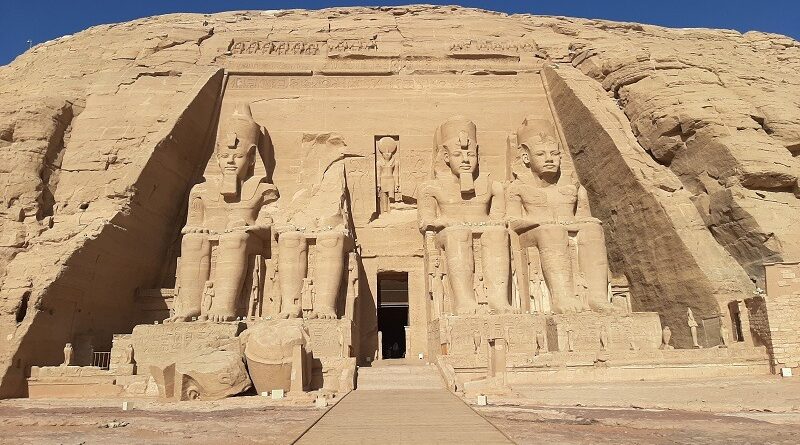
Uncover the grand Temple of Abu Simbel, a UNESCO World Heritage Site, with ancient Egyptian architecture and and rich history. Stop by its marvels today.
The temple of Abu Simbel is a double rock temple in southern Egypt. It was sculpted out of a mountain during the 13th century BC in the reign of Pharaoh Ramesses II. The site is a lasting testament to Ramesses II and his favorite wife, Queen Nefertari. The majestic buildings are eternal symbols of power, love, and fidelity that represent the majesty and refinement of Ancient Egyptian civilization.
The Majesty of Ancient Egyptian Architecture in Abu Simbel
The temples, too, reveal the archetypal spirit of ancient Egyptian architecture by their imposing statues and fine carvings. The larger temple in Abu Simbel is a temple to Ramesses II himself, and four colossal seated statues of the pharaoh dominate the front facade. Each of them is approximately 20 meters tall, revealing the magnificence which had followed the divine kingship of Egypt.
Inside the temples, the architecture is impressive too. The main temple consists of three adjacent halls, each of which is covered in beautiful reliefs presenting the pharaoh in religious and combat scenes. Not only are the carvings beautiful works of art, but also the pharaoh’s version of history of his deeds and divine presence.
The smaller temple, which belonged to Queen Nefertari, is equally beautiful, although smaller in size. There are six statues on the facade, four of Ramesses and two of Nefertari, that stand about 10 meters tall each. This temple stands out from the rest where a queen has been depicted as equal to the pharaoh, showing Nefertari’s importance. The interior walls are adorned with magnificent carvings of the queen’s heavenly and earthly kingdoms.
Abu Simbel: A Must-Visit Tourist Destination in Egypt
Abu Simbel temple is currently among Egypt’s largest attractions, welcoming thousands of people from around the world every year. The remoteness of the location adds an extra element of adventure to those who make the pilgrimage, who can either take a beautiful airplane trip or boat tour along Lake Nasser to reach the temples. Upon arrival, the sheer enormity and majesty of the structures present an experience that will be remembered.
The visitor center provides informative historical context, replete with documentaries and exhibits that recount the building, rediscovery, and relocation of the temples. In the 1960s, these mythical landmarks were moved from their original location to prevent them from being inundated due to the construction of the Aswan High Dam. This monumental effort provided the global realization of the importance of protecting these historic marvels.
Traveling to Other Famous Temples in Egypt
While Abu Simbel is undoubtedly a highlight, Egypt boasts many other iconic temples that are just as intriguing. The Temple of Karnak at Luxor, another architectural icon that whispers the history of multiple pharaohs in its vast complex of sanctuaries, kiosks, pylons, and obelisks, is another. The twin Temples of Kom Ombo, which are dedicated to the gods Sobek and Horus, uncover the duality of ancient Egyptian religion.
The Temple of Edfu, which is a temple dedicated to the god Horus, is Egypt’s best-preserved temple, featuring stunning reliefs and columns that remind individuals of ancient times. The Temple of Hatshepsut, a relic of one of Egypt’s rare female pharaohs, is tucked against a picturesque cliff face and reminds individuals of her reign and divine relationship.
Witnessing the Ancient Architectural Wonders of Egypt
Egypt’s historical architectural riches are not limited to temples. The Great Pyramids of Giza, with the Sphinx guarding their sacred premises, are exemplary instances of engineering prowess and architectural prowess beyond compare. The Valley of the Kings, where several pharaohs were entombed, features tombs that are ornately decorated and harboring murals recounting the journey to the afterlife.
The red and curved pyramids of Dahshur, and the step pyramid of Djoser at Saqqara, are snapshots of the process of evolving pyramid construction. Each is a testament to the ingenuity, religious devotion, and artistic creativity of the ancient Egyptian culture.
The Everlasting Tale of Ancient Love Affairs: Ramesses II and Nefertari
Abu Simbel temple is not only architectural marvels; they are also enduring reminders of a romance between a king and his queen. Ramesses II built the smaller temple in dedication to his queen, Nefertari, whom he dearly loved. The inscriptions on the temple refer to the immense love Ramesses had for Nefertari, proclaiming her to be the one “for whom the sun shines.”
The common interest shared between Ramesses and Nefertari is carved into every aspect of the temple’s construction. The mutual emphasis placed on Nefertari as well as the pharaoh in the sculpture demonstrates a lasting respect and affection that exceeded the common conventions accorded to queens. This marriage between a great pharaoh and his favorite queen is an epic tale that continues to intrigue tourists who come to recreate the awe of the Abu Simbel temples.
Conclusion: The Lasting Charm of Abu Simbel
Abu Simbel’s temple is slightly more than ruins from the ancient world; they are a witness to human imagination, faith, and the infinite strength of love. They give us a glimpse of an era when heroic artistry and engineering were used to extol gods, commemorate dominions, and mourn the filial bonds. When travelers halt before these colossal monuments, they are reminded of the enduring legacy of Ramesses II and Nefertari—a commitment not merely to their dynasty but also to their eternal love.


